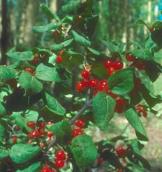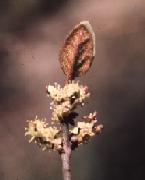
USDA Forest Service

USDA Forest Service
Canadian Buffalo-Berry
Shepherdia canadensis Nutt.
It is a shrub 2-4 feet tall with opposite leaves and ray branches. It has dark green leaves that are somewhat leathery with prominent mid-vein, often curled under at the sides, buds and undersides of leaves with reddish, scurfy scales. The berries are translucent orange-red when ripe, edible, though very bitter. Woods and open, rocky slopes in the mountains from 1700 to 3300 mountain elevation. Found in suitable habitats in most of the mountains in the Intermountain area.
Food Use: Fruit may be eaten raw or cooked. The fruit can also be dried and used like currants. A tart but pleasant flavor even before a frost, it becomes sweeter after frosts. Another report says that the fruit is bitter and is dried, smoked or pressed into cakes. The fruit was a favorite treat of the North American Indians, they would beat it in an equal quantity of water until a foam with a consistency of beaten eggs was formed. It was important that the berries were not allowed to come into contact with anything greasy since this would prevent it becoming foamy The foam would then be flavored with a sweet food such as cooked quamash bulbs or other fruits and then served as a special treat in feasts etc. The taste is bitter sweet and is not always enjoyed the first time it is eaten, though it normally grows on one. Nowadays sugar is used to sweeten it and the confection is called 'Indian ice cream'. The fruit should be used in moderation due to the saponin content. The fruit is about 1 to 2 inches in diameter.
Medicine: Buffalo berry was commonly employed medicinally by several
native North American Indian tribes, who used it in the treatment of a range of
complaints. It is little, if at all, used in modern herbalism.
A poultice of the bark, softened by hot water and mixed with pin cherry bark, has been used to make a plaster or bandage for wrapping broken
limbs. An infusion of the bark has been used as a wash for sore eyes. The roots
are amti-hemorrhagic and cathartic. An infusion of the roots has been used as an
aid to childbirth and in the treatment of tuberculosis and the coughing up of
blood. A decoction of the stems has been used as a stomach tonic (it was also
used to treat stomach cancer) and also in the treatment of constipation, high
blood pressure and venereal disease. A decoction of the stems and leaves has
been used as a wash in the treatment of sores, cuts and swellings. A decoction
of the plant has been used externally as a wash and rub for aching limbs,
arthritic joints, head and face sores. The inner bark is laxative. An infusion
has been used in the treatment of constipation. The berries have been eaten as a
treatment for high blood pressure. The fruit juice has been drunk in the
treatment of digestive disorders. It has also been applied externally in the
treatment of acne and boils.
Other uses: Because of its saponin content, the fruit is a potential soap substitute. It is macerated in water to extract the saponins. A decoction of the branches has been used as a hair tonic for dyeing and curling the hair The branches were harvested in mid summer, broken up and boiled for 2 - 3 hours in water, until the liquid looked like brown coffee. The liquid was decanted off and bottled without further treatment - it would store for a long time without deterioration. To use, the decoction was rubbed inti the hair which was simultaneously curled and dyed a brownish color. The berries, the froth made from them, or a jelly of the fruit, have been eaten as an insect repellent. It was said that mosquitoes were far less likely to bite a person who had eaten the fruit.
Value to Wildlife:
Canadian buffalo berry provides only fair forage for sheep. Mule deer,
white-tailed deer, and elk use has been rated from fair to good. Snowshoe
hares utilize russet buffalo berry as browse, but it is not preferred. Bighorn
sheep use it as a low-preference shrub, with moderate to heavy use of new growth
in early June. Dormant plants are used in proportions equal to or greater than
their availability. Wildlife use berries more frequently than browse. Black
bears, grizzly bears, and grouse make substantial use of them in the fall.
Berries provide the major food from midsummer until frost for black bear. (Source)
Planting: Succeeds in an ordinary well-drained moisture retentive soil. Tolerates poor dry soils and maritime exposure. Established plants are drought resistant. This species has a symbiotic relationship with certain soil bacteria, these bacteria form nodules on the roots and fix atmospheric nitrogen. Some of this nitrogen is utilized by the growing plant but some can also be used by other plants growing nearby. Cuttings of half-ripe wood, July/August in a frame sometimes work.

Vascular Plant Image Gallery